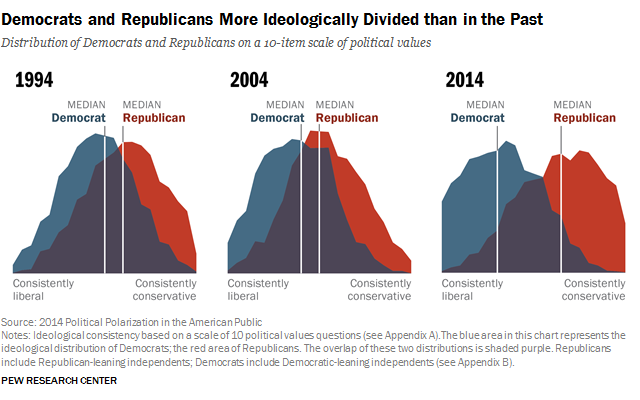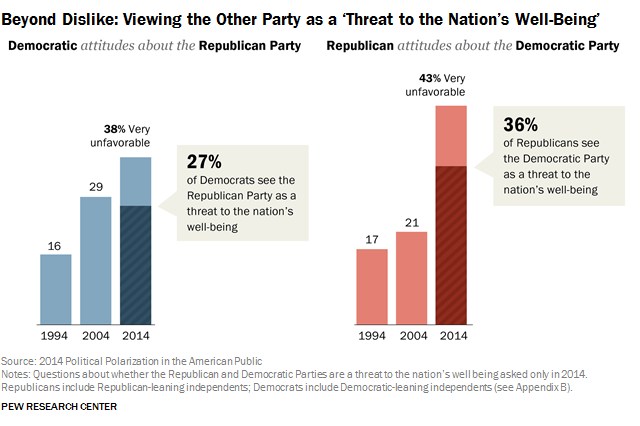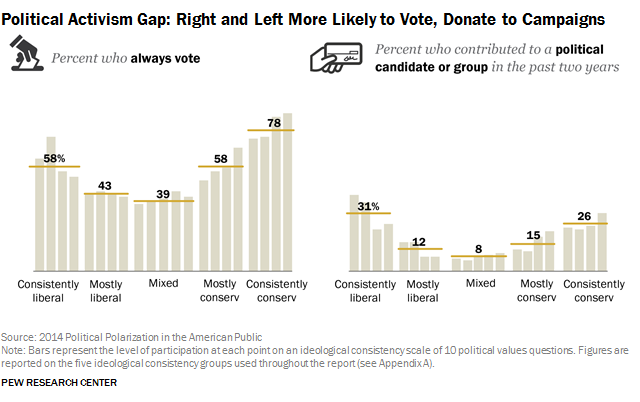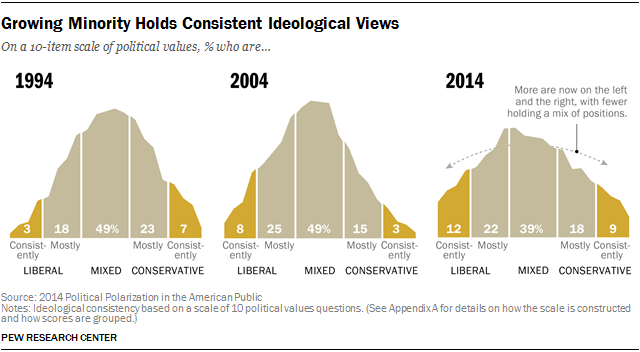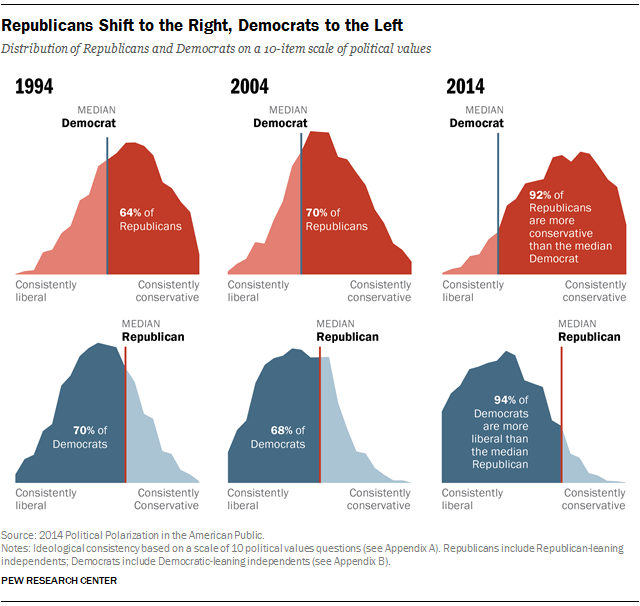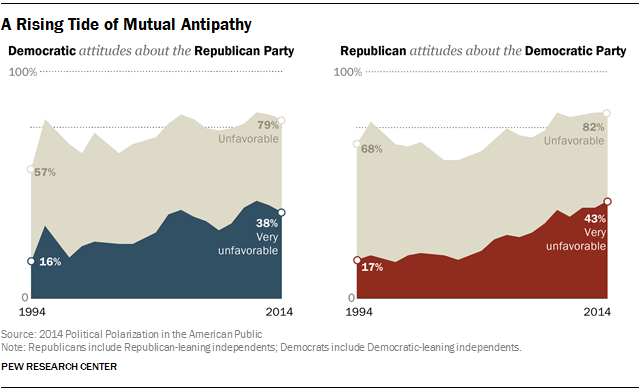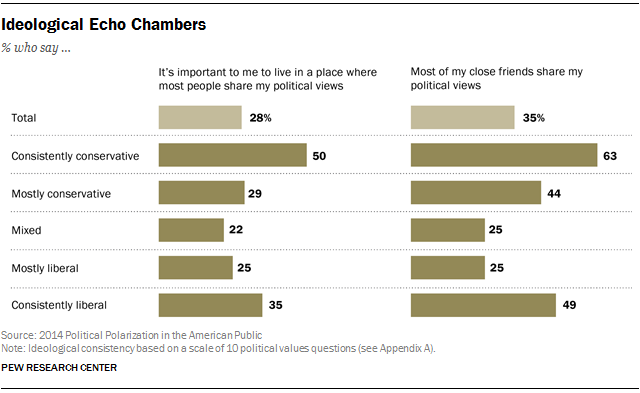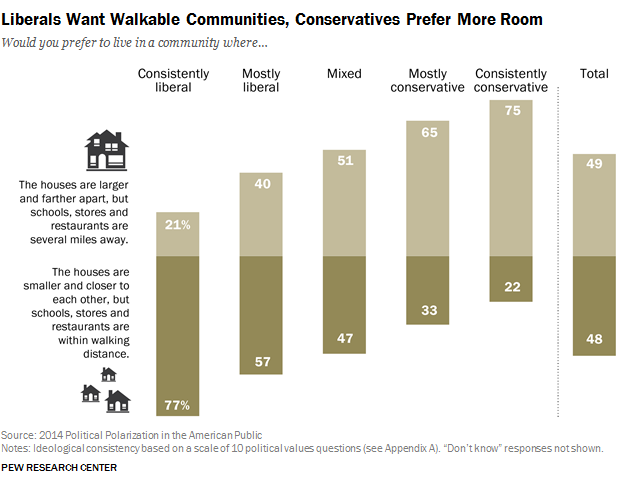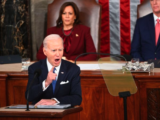How Increasing Ideological Uniformity and Partisan Antipathy Affect Politics, Compromise and Everyday Life
ANALYSIS –
By Glynn Wilson –
Republicans and Democrats are more divided along ideological lines – and partisan antipathy is deeper and more extensive – than at any point in the last two decades, according to a new research study from the Pew Research Center for People and the Press.
These trends manifest themselves in many ways, both in politics and everyday life, according to this new survey of 10,000 adults nationwide, which finds that these divisions are greatest among those who are the most engaged and active in the political process.
The overall share of Americans who express consistently conservative or consistently liberal opinions has doubled over the past two decades from 10 percent to 21 percent. Ideological thinking is now much more closely aligned with partisanship than in the past, according to Pew. “As a result, ideological overlap between the two parties has diminished: Today, 92 percent of Republicans are to the right of the median Democrat, and 94 percent of Democrats are to the left of the median Republican.”
Partisan animosity has increased substantially over the same period. In each party, the share with a highly negative view of the opposing party has more than doubled since 1994. Most of these intense partisans believe the opposing party’s policies “are so misguided that they threaten the nation’s well-being.”
“Ideological silos” are now common on both the left and right. People with down-the-line ideological positions – especially conservatives – are more likely than others to say that most of their close friends share their political views.
Liberals and conservatives even disagree on where they want to live, the kind of people they want to live around and whom they would welcome into their families.
And at a time of increasing gridlock on Capitol Hill, many on both the left and the right think the outcome of political negotiations between President Obama and Republican leaders should be that their side gets more of what it wants.
“These sentiments are not shared by all – or even most – Americans. The majority do not have uniformly conservative or liberal views,” according to Pew’s research, a fact I have reported many times before and could provide an opportunity for up-and-coming politicians who want to potentially reach moderate, mainstream American voters, today’s independents.
“Most (Americans) do not see either party as a threat to the nation,” Pew finds.
More believe their representatives in government should meet halfway to resolve contentious disputes rather than hold out for more of what they want, although again these views are held by people are not necessarily engaged in the political process and may think both parties are useless and corrupt. These people may not think there is a reason to show up and vote at all, leaving the decisions over who is in charge of running the government to the partisans on both sides of the political divide.
“Yet many of those in the center remain on the edges of the political playing field, relatively distant and disengaged, while the most ideologically oriented and politically rancorous Americans make their voices heard through greater participation in every stage of the political process,” Pew says.
The rise of ideological uniformity has been much more pronounced among those who are the most politically active.
Almost four-in-ten (38 percent) politically engaged Democrats are consistent liberals, up from just 8 percent in 1994. The change among Republicans since then appears less dramatic – 33 percent express consistently conservative views, up from 23 percent in the midst of the 1994 “Republican Revolution.”
“But a decade ago, just 10 percent of politically engaged Republicans had across-the-board conservative attitudes,” Pew says.
On measure after measure – whether primary voting, writing letters to officials, volunteering for or donating to a campaign – the most politically polarized are more actively involved in politics, amplifying the voices that are the least willing to see the parties meet each other halfway.
To chart the progression of ideological thinking, Pew has gathered responses to 10 political values questions on multiple surveys since 1994. They have now been combined to create a measure of ideological consistency.
Over the past 20 years, the number of Americans in the “tails” of this ideological distribution has doubled from 10 percent to 21 percent.
“Meanwhile,” Pew says, “the center has shrunk: 39 percent currently take a roughly equal number of liberal and conservative positions. That is down from about half (49 percent) of the public in surveys conducted in 1994 and 2004.”
And this shift represents both Democrats moving to the left and Republicans moving to the right, with less and less overlap between the parties.
Today, 92 percent of Republicans are to the right of the median (middle) Democrat, compared with 64 percent 20 years ago. And 94 percent of Democrats are to the left of the median Republican, up from 70 percent in 1994.
“Beyond the rise in ideological consistency, another major element in polarization has been the growing contempt that many Republicans and Democrats have for the opposing party,” Pew finds. “To be sure, disliking the other party is nothing new in politics. But today, these sentiments are broader and deeper than in the recent past.”
In 1994, hardly a time of amicable partisan relations, a majority of Republicans had unfavorable impressions of the Democratic Party, but just 17 percent had very unfavorable opinions. Similarly, while most Democrats viewed the GOP unfavorably, just 16 percent had very unfavorable views. Since then, highly negative views have more than doubled: 43 percent of Republicans and 38 percent of Democrats now view the opposite party in strongly negative terms.
Even these numbers tell only part of the story. Those who have a very unfavorable impression of each party were asked: “Would you say the party’s policies are so misguided that they threaten the nation’s well-being, or wouldn’t you go that far?” Most who were asked the question said yes, they would go that far. Among all Democrats, 27 percent say the GOP is a threat to the well-being of the country. That figure is even higher among Republicans, 36 percent of whom think Democratic policies threaten the nation.
Politics Gets Personal
Liberals and conservatives share a passion for politics. They are far more likely than those with more mixed ideological views to discuss politics on a weekly or daily basis. But for many, particularly on the right, those conversations may not include much in the way of opposing opinions.
Nearly two-thirds (63 percent) of consistent conservatives and about half (49 percent) of consistent liberals say most of their close friends share their political views. Among those with mixed ideological values, just 25 percent say the same.
People on the right and left also are more likely to say it is important to them to live in a place where most people share their political views, though again, that desire is more widespread on the right (50 percent) than on the left (35 percent).
And while few Americans overall go so far as to voice disappointment with the prospect of a family member marrying a Democrat (8 percent) or a Republican (9 percent), that sentiment is not uncommon on the left or the right. Three-out-of-ten (30 percent) consistent conservatives say they would be unhappy if an immediate family member married a Democrat and about a quarter (23 percent) of across-the-board liberals say the same about the prospect of a Republican in-law.
To be sure, there are areas of consensus. Most Americans, regardless of their ideological preferences, value communities in which they would live close to extended family and high-quality schools. But far more liberals than conservatives think it is important that a community have racial and ethnic diversity (76 percent vs. 20 percent). At the same time, conservatives are more likely than liberals to attach importance to living in a place where many people share their religious faith (57 percent vs. 17 percent of liberals).
The differences between right and left go beyond disagreements over politics, friends and neighbors. If they could choose anywhere to live, three-quarters of consistent conservatives prefer a community where “the houses are larger and farther apart, but schools, stores, and restaurants are several miles away.” The preferences of consistent liberals are almost the exact inverse, with 77 percent saying they’d chose to live where “the houses are smaller and closer to each other, but schools, stores, and restaurants are within walking distance.”
Polarization’s Consequences
When they look at a political system in which little seems to get done, most Americans in the center of the electorate think that President Obama and Republican leaders should simply meet each other halfway in addressing the issues facing the nation.
Yet an equitable deal is in the eye of the beholder, as both liberals and conservatives define the optimal political outcome as one in which their side gets more of what it wants. A majority of consistent conservatives (57 percent) say the ideal agreement between President Obama and congressional Republicans is one in which GOP leaders hold out for more of their goals. Consistent liberals take the opposite view: Their preferred terms (favored by 62 percent) end up closer to Obama’s position than the GOP’s.
Polarization in Red and Blue
The signs of political polarization are evident on both ends of the political spectrum, though the trajectory, nature and extent differ from left to right.
With Barack Obama in the White House, partisan antipathy is more pronounced among Republicans, especially consistently conservative Republicans. Overall, more Republicans than Democrats see the opposing party’s policies as a threat and the differences are even greater when ideology is taken into account.
Fully 66 percent of consistently conservative Republicans think the Democrats’ policies threaten the nation’s well-being. By comparison, half (50 percent) of consistently liberal Democrats say Republican policies jeopardize the nation’s well-being. Conservatives also exhibit more partisan behavior in their personal lives; they are the most likely to have friends and prefer communities of like-minded people.
However, there is as much ideological uniformity on the left as the right. The share of Democrats holding consistently liberal views has grown steadily over the past 20 years, quadrupling from 5 percent in 1994 to 23 percent today. Social issues like homosexuality and immigration that once drove deep divides within the Democratic Party are now areas of relative consensus. And Democrats have become more uniformly critical of business and more supportive of government.
Changes in ideological consistency on the right have followed a different course. In 1994, during the “Republican Revolution,” 13 percent of Republicans were consistent conservatives. That figure fell to 6 percent a decade later during George W. Bush’s presidency, before rebounding to 20 percent today. This increase has come despite more moderate views among Republicans on issues like homosexuality and immigration, as GOP thinking on issues related to government and the economy has veered sharply to the right.
Implications
The overriding implications of this indicate that solving problems is becoming harder and harder in American life and threatens to unravel the experiment in democracy itself. One side seeks to make the government work to form public policies that make life better in America, while the other side sees the government as the problem.
Until more mainstream, working class people get engaged and involved in the political process on the right side of the debate, the left side, there will be no end in sight to the sensational partisan divide that dominates media coverage of politics in the U.S.
The mainstream media and partisan cable news shows are going to continue reporting the most sensational drivel as if that point of view was legitimate, such as the so-called “debate” over climate change science. It is clear that much of the public is not paying attention to this stuff anymore, but the research also indicates that a large percentage of the mass public are also not involved in the political process.
There is an opportunity here for up-and-coming politicians who can figure out a way to appeal to uninvolved independent voters in a way that motivates them to get involved.
About the Study
This is the first report of a multi-part series based on a national survey of 10,013 adults nationwide, conducted January 23-March 16, 2014 by the Pew Research Center. The survey, funded in part through grants from the William and Flora Hewlett Foundation, the John D. and Catherine T. MacArthur Foundation and supported by the generosity of Don C. and Jeane M. Bertsch, is aimed at understanding the nature and scope of political polarization in the American public, and how it interrelates with government, society and people’s personal lives.
The second report, coming in a few weeks, is the new Pew Research Center Political Typology. The typology – the sixth such study since 1987 – looks beyond Red vs. Blue divisions to gain a clearer understanding of the dynamic nature of the “center” of the American electorate, and the internal divides on both the left and the right.
Later, the project will explore the various factors that contribute to political polarization, or stem from it. A September report will examine how political polarization is linked to people’s information environments: Their news sources, social media habits and interpersonal communication networks. Other reports will look at how political polarization relates to where people live, to their political environments, to how they view themselves and others around them, to their socioeconomic circumstances, to generational changes and to broader sociological and psychological personality traits.
The current report is divided into five parts: The first two focus on measuring the nature and scope of political polarization, emphasizing the difference between growing ideological consistency and rising partisan antipathy. The third looks closely at how polarization manifests itself in people’s personal lives. The fourth looks at the relationship between polarization and practical policymaking, and the fifth digs deeper into how political participation both amplifies and reflects polarization.
About the Data
The data in this report are based on two independent survey administrations with the same randomly selected, nationally representative group of respondents. The first is the center’s largest survey on domestic politics to date: the 2014 Political Polarization and Typology Survey, a national telephone survey of 10,013 adults, on landlines and cell phones, from January through March of this year. The second involved impaneling a subset of these respondents into the newly created American Trends Panel and following up with them via a survey conducted by web and telephone. The two surveys are described separately, in further detail, in the About the Surveys section of the report.
See more from the Pew Research Center for People and the Press: Political Polarization in the American Public
Before you continue, I’d like to ask if you could support our independent journalism as we head into one of the most critical news periods of our time in 2024.
The New American Journal is deeply dedicated to uncovering the escalating threats to our democracy and holding those in power accountable. With a turbulent presidential race and the possibility of an even more extreme Trump presidency on the horizon, the need for independent, credible journalism that emphasizes the importance of the upcoming election for our nation and planet has never been greater.
However, a small group of billionaire owners control a significant portion of the information that reaches the public. We are different. We don’t have a billionaire owner or shareholders. Our journalism is created to serve the public interest, not to generate profit. Unlike much of the U.S. media, which often falls into the trap of false equivalence in the name of neutrality, we strive to highlight the lies of powerful individuals and institutions, showing how misinformation and demagoguery can harm democracy.
Our journalists provide context, investigate, and bring to light the critical stories of our time, from election integrity threats to the worsening climate crisis and complex international conflicts. As a news organization with a strong voice, we offer a unique, outsider perspective that is often missing in American media.
Thanks to our unique reader-supported model, you can access the New American journal without encountering a paywall. This is possible because of readers like you. Your support keeps us independent, free from external influences, and accessible to everyone, regardless of their ability to pay for news.
Please help if you can.
American journalists need your help more than ever as forces amass against the free press and democracy itself. We must not let the crypto-fascists and the AI bots take over.
See the latest GoFundMe campaign here.
Don't forget to listen to the new song and video.
Just because we are not featured on cable TV news talk shows, or TikTok videos, does not mean we are not getting out there in search engines and social media sites. We consistently get over a million hits a month.
Click to Advertise Here


